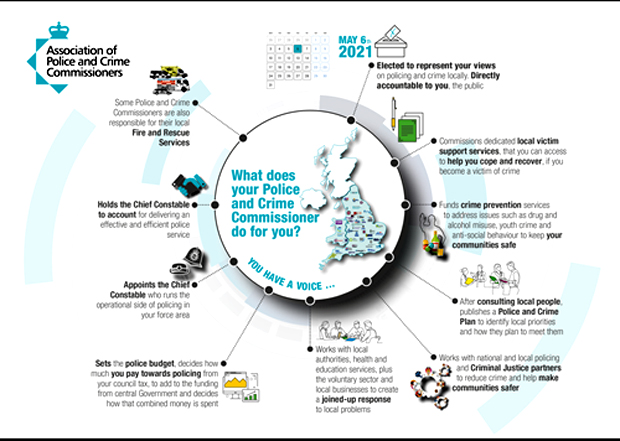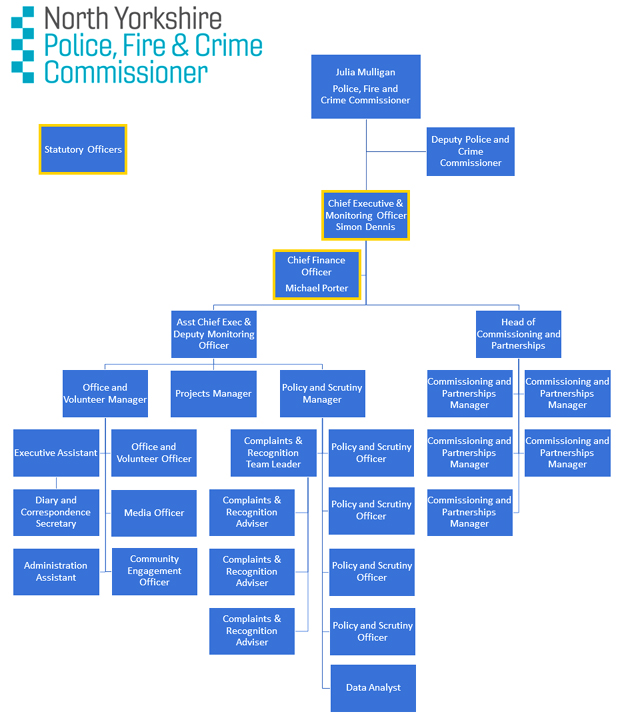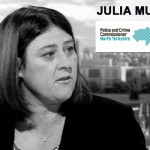On the 6th of May, elections will be held to determine who will be the next Police Fire and Crime Commissioner (PFCC) for North Yorkshire.
The NYE will therefore be running an Election Special consisting of a series of articles covering the election. This will include analysis of the role of a PFCC, the background to the election, an assessment of the current incumbent PFCC Julia Mulligan (pictured above) of the Conservative Party, interviews with all the candidates and coverage of election issues as they arise.
2021 PFCC Election Special – 1
by TIM HICKS
~~~~~
Background: PFCCs
Police & Crime Commissioners (PCCs) are elected officials who were first introduced in 2012. PCCs were elected for the second time on the 5th of May 2016. Every police force has a PCC, except Greater Manchester and London, where PCC responsibilities lie with the Mayor.
The Policing & Crime Act 2017 allowed PCCs to take on responsibility for Fire & Rescue governance. Under this legislation PCCs could consult the public and submit a business case to the Home Secretary seeking to replace the Fire and Rescue Authority in their area, which would change the PCC into a Police, Fire & Crime Commissioner (PFCC).
In North Yorkshire, the PCC elected to take responsibility for the Fire & Rescue authority, so North Yorkshire has a PFCC, not a PCC.
Introduction: What is a PFCC and what does it do?
The duties of a PFCC are as follows:
Policing responsibilities
The role of the PFCCs is to be the voice of the people and hold the police to account. They are responsible for the totality of policing.
PFCCs aim to cut crime and deliver an effective and efficient police service within their force area.
PFCCs have been elected by the public to hold Chief Constables and the force to account; effectively making the police answerable to the communities they serve.
PCCs ensure community needs are met as effectively as possible, and are improving local relationships through building confidence and restoring trust. They work in partnership across a range of agencies at local and national level to ensure there is a unified approach to preventing and reducing crime.
Under the terms of the Police Reform and Social Responsibility Act 2011, PCCs must:
- secure an efficient and effective police for their area;
- appoint the Chief Constable, hold them to account for running the force, and if necessary dismiss them;
- set the police and crime objectives for their area through a police and crime plan;
- set the force budget and determine the precept;
- contribute to the national and international policing capabilities set out by the Home Secretary;
and
- bring together community safety and criminal justice partners, to make sure local priorities are joined up.
The duties of a PFCC are nicely summarised in the diagram below.

Fire responsibilities
PFCCs are responsible for:
- putting in place arrangements to deliver an efficient and effective fire and rescue service;
- setting the fire and rescue objectives for their area through a fire and rescue plan;
- appointing the Chief Fire Officer, hold them to account for delivery of objectives, and if necessary dismiss them;
and
- setting the service budget and determining the precept.
PFCCs are expected to adhere to the Seven Principles of Public Life, as determined and published by the Nolan Committee – The Nolan Principles of the Seven Standards in Public Life
Office of the Police Fire & Crime Commissioner
The PFCC is supported by an extensive staff that makes up the Office of the Police and Crime Commissioner (OPFCC). According to the diagram below, this consists of twenty eight roles, of which two are statutory officers, which are shown in the diagram below, taken from the PFCCs website on the 7th of April 2021.

However:
- The PFCC’s website Meet the Team section names twenty five individuals that fulfil the above roles, five of whom are listed under the heading “Statutory Officers”, although there should only be two.
- There is only one Assistant Chief Executive & Deputy Monitoring Officer shown as authorised on the above diagram, which position is vacant. It does not disclose that there are two “Interim Assistant Chief Executive & Deputy Monitoring Officers” employed, one of whom is presumably not authorised. Hence perhaps the reason his existence is not disclosed on the diagram.
- Three roles are listed as vacant, which with the twenty five named individuals makes up the twenty eight authorised staff. However the Data Analyst role is also vacant, but this is undisclosed, making a total of twenty nine, so it appears that the OPFCC is carrying more roles and people than it is authorised to.
- The website then goes on to state:
“OPFCC team makeup
-
-
- Of the 22 staff currently in post, 19 are women, six are men.
- None are from an ethnic minority.
- One has a registered disability.”
-
Indicating there are twenty-two employees currently in post, not the twenty-five disclosed, or the twenty-eight that are authorised
- The website states: “For more information, see item 8 Leedership Staffing Update presented to the Police Fire & Crime Pannel on 19 August 2020” (please note this is taken from the PFCC website and the spelling mistakes are not mine). However, this leads to a North Yorkshire County Council Agendas Minutes and Reports page saying “Error not available”.
In summary, analysis of the website to identify what everyone does and how many of them there are has proven to be impossible. I have therefore been unable to determine what the authorised headcount is, whether it is twenty eight or twenty nine, how many of the above roles are statutory roles whether it is one or two or five, or how many people there are in the OPFCC, whether it is 22, 25, 28, 29 or more.
I have written to PFCC Mulligan asking her to ensure the website is corrected, so it does not mislead the public during the election.
Role of the Police, Fire & Crime Panel
The North Yorkshire Police Fire & Crime Panel (PCP) is supposed to scrutinise and support the work of the PFCC and can require the PFCC to appear before it to answer their questions.
The PCP is required to support the PFCC and provide a check and balance in relation to the performance of the PFCC.
The PCP does not scrutinise the Chief Constable – it scrutinises the PFCC’s exercise of their statutory functions.
While the PCP has a role in challenging the PFCC, it must also exercise its functions with a view to supporting the effective exercise of the PFCC’s functions.
The Policing Protocol goes on to provide a list of the main functions and powers of the PCP, the most important of which are:
- a power of veto over the precept;
- a power of veto over the appointment of a Chief Constable;
- a power to hold confirmation hearings (but not veto) in relation to other senior OPFCC staff (Chief Executive, Chief Finance Officer and Deputy PCC);
- a power to appoint an acting PFCC where the incumbent PFCC is incapacitated, resigns or is disqualified;
- responsibility for complaints about a PFCC, although serious complaints and conduct matters must be passed to the Independent Office of Police Conduct;
and
- responsibility to review and make recommendations on the PFCC’s Police and Crime Plan.
If the PCP seeks to scrutinise the PFCC on an operational matter, the Chief Constable may be invited (but cannot be required) to attend alongside the PFCC to offer factual accounts and clarity (if needed) of the Chief Constable’s actions and decisions.
The accountability of the Chief Constable remains firmly to the PFCC and not to the PCP.
-
- Source: North Yorkshire PFCC Website
Councillor Les has very helpfully provided a media comment to the NYE on the way that the PCP operates. The PCP doesn’t often formally vote and when it does, it is usually only on constitutional items like setting the precept. It prefers to do most things by consensus and he can`t remember a time when the panel may have divided on party lines.
The make-up of the PCP reflects the proportionate political make-up of the District Councils, the North Yorkshire County Council and the City of York Council. It has changed over the years the Panel has been operating. According to the PCP website Governance Police & Crime Panel there were ten Councillors on the PCP on the 8th of April 2021. Five are Conservatives, two Liberal Democrat, one Labour and two Independents. The Chairman is Councillor Carl Les (Conservative); Councillor Ashley Mason JP (Liberal Democrat) and Councillor Peter Wilkinson (Conservative) serve as Vice Chairman. In addition there are two independent co-opted members.
This means that while they do not have an overall majority, the Conservative Party dominates the PCP because it only takes one or two of the other Councillors to agree with the Conservatives and they can determine what line the panel will take on a given issue.
This has had major implications for the effectiveness and attitude of PFCC Mulligan as we shall see in the next article.
The last election
PFCCs are elected every 4 years. The election for the next North Yorkshire PFCC was due to be held on the 7th of May 2020, but was postponed due to the coronavirus pandemic. The election will now be held on Thursday the 6th of May 2021.
The 2016 election was run using proportional representation and the results were as follows:
First Choice Voting:
Conservative 53,078
Labour 34,351
Independent 30,984
LibDem 13,856
As no candidate won over 50%, the second preferences of the Independent and LibDem candidates were distributed to the two leading (Conservative and Labour) candidates. More of the second choice votes by Lib Dems and Independents went to the Conservative candidate than to the Labour candidate, giving a resounding victory for the Conservative candidate and current PFCC, Mrs Julia Mulligan:
Second Choice Voting:
Conservative 65,018
Labour 44,759
As shown above, the candidates are nominated by political parties, with one independent. In my opinion this is unfortunate. Unlike the role of a local councillor, the role of PFCC is not really affected by party political policy, being based more around local issues of crime, holding the police to account and value for money.
However, because three of the candidates are sponsored by political parties, the nature of the voting public in North Yorkshire means that the Conservative candidate has been voted in each election -not because he or she is necessarily better suited to the job- but because they are on the Conservative ticket. This may be partially the result of the poor media coverage, which has not given the voters enough information about the candidates so they can distinguish the relative strengths of the individual candidates.
Traditionally, elections for the PCC have had a very low turnout. In 2012 the turnout was 13.3%; in 2016 it was 22.47%. This is in part due to voter apathy and also to a failure by the media to give the PCC elections an appropriate level of publicity, compared say to local council elections. It is also concern that because of the COVID 19 pandemic, the turnout will be even lower this year.
This is a shame, because in real terms, the PFCC is a more important officer than that of any local councillor, having real power over a large budget and critically important services. It is vital that local people use their right to vote on this critical appointment. So the NYE is covering the elections with an Election Special series of articles, to provide an appropriate level of coverage for this critical role and to encourage more people to vote.
If you are not eligible to vote, applications to vote can be made online: https://www.gov.uk/register-to-vote
The deadlines for registration to vote, nomination of candidates, etc, are set out in this Notice of Election.
PFCC Mulligan had a complaint of bullying upheld against her and following parliamentary criticism of her management style, the Conservatives withdrew her automatic nomination to be the next Conservative candidate for PFCC, effectively de-selecting here. NYE article here.
PFCC Mulligan decided not to seek adoption as the Conservative party candidate and so the Conservatives will be represented by a new candidate in the 2021 election. NYE article here.
PFCC Julia Mulligan: An assessment – Part 1
I have been covering crime in North Yorkshire since 2012 and, in common with other media outlets, my interaction with PFCC Mulligan and her staff has been negative and disappointing. But in assessing her tenure as PFCC, I will try to be impartial.
PFCC Mulligan has had many successes since she was first elected as the Conservative candidate in 2012. She has:
- Raised the profile of the PFCC in North Yorkshire very significantly. The PFCC website is sophisticated and covers all of her activities and many local and national policing issues. See here.
- Introduced public accountability webchats, which have improved the accessibility of the police and the fire service to the public. Example here.
- Improved the support victims receive in North Yorkshire and appears to be genuinely concerned over this aspect of policing.
- Held the national portfolio as chair of the National Rural Crime Network and has used this position effectively to raise awareness of the impact of rural crime.
- Made the decision to move NYP Force Headquarters from Newby Wiske Hall to Alverton Court, which was long overdue. But see below.
- Made the decision to replace the Fire and Rescue Authority in North Yorkshire, thereby transforming her role into a Police, Fire and Crime Commissioner and this appears to have been a success.
- Overseen the move of the Fire Service Headquarters into Alverton Court, so that both services were housed in the same building.
- Tried to achieve efficiencies through collaboration between the police, fire service and local government organisations.
- Developed a reputation for being hard working at the role and committed to it.
Fire Annual Report here
Policing & Crime Annual Report here
These are all significant achievements and PFCC Mulligan is to be respected for them.
However, her tenure as PFCC from 2012 until 2021 has been deeply controversial.
Coming next
In my next article, I will continue my assessment of PFCC Mulligan’s performance as PCC and then PFCC, focussing on the controversies that have undoubtedly led to her downfall as PFCC and the end of her political career.
Mrs Mulligan and the North Yorkshire Police and Crime Panel have had access to a draft of this article and an opportunity to comment.
Right of Reply
If you are mentioned in this article and do not agree with the views expressed in it, or if you wish to correct any factual inaccuracy, please let me know using the letters@nyenquirer.uk e mail address and your views and a correction will be published if appropriate.


























Comments are closed.